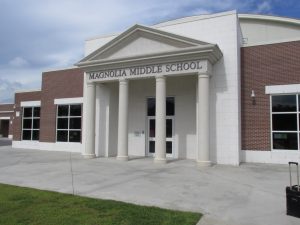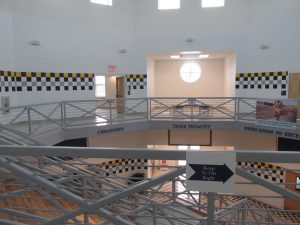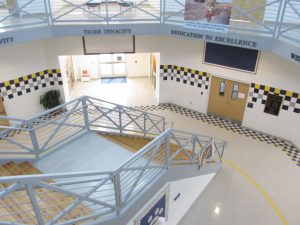
©Michael Dorn Safe Havens International 2020
Magnolia Middle School in Mississippi serves as an excellent example of how architects with a high degree of expertise of the utilization of crime prevention through environmental design can create safer and more welcoming schools.

©Michael Dorn Safe Havens International 2020
Thoughtful utilization of CPTED in school design can reduce the types of hidden and difficult to supervise areas that are the locations of many sexual assaults, acts of vandalism, deaths from medical emergencies, drug overdoses and homicides. The open stairwell and extensive use of magnetic holdback devices on stairwells and main hallways dramatically reduce the risk of death in schools.

©Michael Dorn Safe Havens International 2020
The thoughtful utilization of visuals creates a greater sense of connectivity which improves school climate. As demonstrated in multiple peer review studies, school climate is one of the most effective ways to reduce the risk of homicide in K12 schools. While CPTED does not replace physical security measures, law enforcement and security personnel, policies, technology, hardware, mental health services, and other important options to enhance security, it is a powerful life-safety tool that can help prevent even heavily secured schools from feeling like prisons. I wrote the original draft of this blog on my return flight from a keynote more than a year ago and it, like a dozen other blogs, was not finished and posted due to the massive workload we have experienced. I am excited to finally get this blog out as I think it is still very timely. Every time a see a new school designed to look like a fortress, built with poor sightlines and other dangerous concepts, I wish more school officials and architects were familiar with crime prevention through environmental design (CPTED) that proves why it is so effective.
I have been blessed to meet many gifted and inspiring advocates for school safety when I keynote conferences. I feel particularly blessed to have met someone whose work I have been admiring for a couple of years now. He is the architect who designed a K12 school that best epitomizes the use of the principles of crime prevention through environmental design (CPTED) I have ever seen.
As a very slow convert to CPTED, I have become a huge proponent of this research-based approach to safer as well as more welcoming schools. CPTED can help architects and school planners create beautiful, more secure schools without degrading school climate and culture in the process. In fact, the thoughtful application of CPTED can increase security while helping to improve school climate and connectivity.
For several years, I have been showing photographs that I took while conducting a site visit to Magnolia Middle School in Moss Point, Mississippi when I present and when I work with clients. If I could recommend only one school for architects and school officials to visit to see a superb example of how CPTED can be used to create safer schools that are also beautiful and welcoming, my choice would be Magnolia Middle School in Moss Point, Mississippi. As I was showing photos of the school during a keynote for the Learning SCAPES School Design Conference in Chicago last year, I happened to mention, as I have at many other architectural conferences, that if anyone in the audience was responsible for this superb design, I would be honored to meet them. As I was answering questions from participants after my presentation, I had the opportunity to do exactly, that. Gary Bailey AIA from Dale Partners Architects informed me that he was indeed the architect who designed this amazing school. As I told Mr. Bailey, it was truly an honor to get to meet someone who was such a gifted practitioner. Though I keynote a lot of school architectural conferences, I feel fortunate to have been able to connect to Mr. Bailey. I shouldn’t be surprised that someone who does such high-end work with CPTED would attend the SCAPES National Conference to continue to learn his craft.
When I visited his website after the conference (http://www.dalepartners.com/about-dba), I learned that Mr. Bailey is a very successful architect whose firm has designed an astounding and increasing number of the schools built in Mississippi in recent years. His work and his success demonstrate that architects who understand how to apply CPTED can be quite successful from a business standpoint while dramatically improving safety for tens of thousands of students and school employees for decades to come. Mr. Bailey and his colleagues will never know how many fights, sexual assaults, acts of vandalism, incidents of gang violence, and perhaps even homicides will not occur due to his skill and expertise. His work will also help many students stay in school and graduate because he has worked closely with his clients to craft welcoming schools where students feel more comfortable and engaged.
I have been truly fortunate to meet so many incredible teachers, school leaders, school resource officers, mental health professionals, coaches, school bus drivers, attorneys, engineers, architects and others who have made our nation’s schools far safer than they were when I was in school. I experienced severe bullying, being robbed at knifepoint and attacked with a box cutter as a student in the 1970’s when violence was so prevalent in our schools. A highly competitive 24/7 media, social media, and the Internet make it easier for those with products, services or ideologies to sow fear with alarmist disinformation and wildly inaccurate data developed to sell using fear. Thankfully, many professionals like Mr. Bailey have been helping schools become safer and more effective places of learning in spite of the hype spewed forth by those who regardless of intent, are doing great damage to our schools and thus hurting the students who represent the future of our nation.